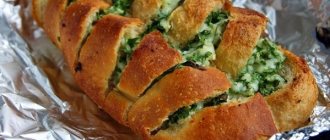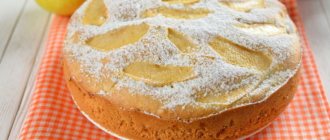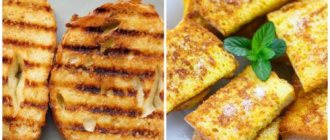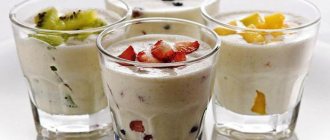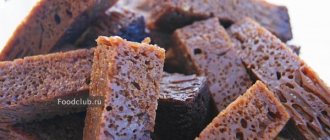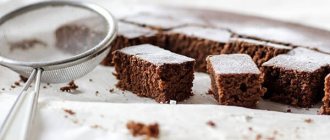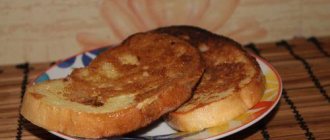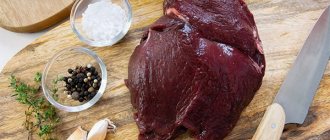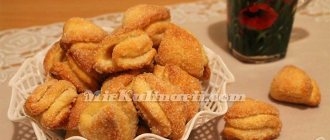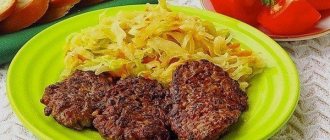Recipe for making gray bread step by step
To make simple homemade bread you need very few ingredients: equal quantities of rye and wheat flour, yeast, water, a little sugar and salt and flavourless sunflower oil. Both fresh and dry yeast are suitable, but in my opinion it is more convenient to use dry yeast.
So, first of all, pour the yeast into a suitable container (glass or glass), add a teaspoon of sugar to it and fill it with heated water (not hot, about 40 degrees, take about half a glass of water).
Let the yeast sit for a while to rise.
Next, in a deep bowl, mix half the wheat flour, salt, suitable yeast and water. Stir everything well, then add the second part of the flour and stir again. It is convenient to use a mixer at this stage.
Then measure out the rye flour.
Add rye flour to the previously obtained mixture.
Then knead it well, the mixer can’t cope with this, the dough turns out to be quite thick, you need to knead it with your hands.
Lastly, add about 50 ml of sunflower oil (or other vegetable oil).
After this, mix well again until smooth and our dough is almost ready. We place it in a deep bowl or pan, the dough will rise, so there should be plenty of space on top in our dishes.
For the next step we will need a clean kitchen towel. We wet it with hot water, squeeze it out and cover the bowl with the dough with a damp hot towel. Then put the dough in a warm place to rise. At this time, be sure to close all windows, vents, etc. to avoid drafts in the kitchen.
After some time, our dough will rise, we need to gently knead it so that it falls and wait until it rises a second time. After this the dough is ready.
Grease the oven molds with sunflower oil (for this amount of dough, 2 “brick” molds), put the dough in them, if desired, future loaves can be cut across. Then we let the dough rise again (in the molds). Turn on the oven to warm up thoroughly.
When the dough has risen, place our molds in a hot oven and bake over low heat for about an hour (baking time greatly depends on the specific oven and the molds used, so we check the readiness with a wooden toothpick or a match). Take the finished bread out of the oven, lightly moisten the crust with water (otherwise it may be rough), cover the bread with a damp towel and let cool. Then remove the finished bread from the molds.
The specified amount of ingredients yielded two hefty loaves. This bread is very tasty, while still a little warm, spread thinly with good butter and gobble it up with aromatic, sweet, black tea.
Choux Borodino bread in a Redmond bread machine
The history of this bread is indirectly connected with the Battle of Borodino. The widow of General Tuchkov founded the Spaso-Borodinsky convent, whose servants invented a recipe for custard rye-wheat bread. The bread was called “Borodinsky”, and pilgrims spread its fame throughout Rus'. Today, the ancient recipe is used almost unchanged. The exception is coriander, which began to be added at the beginning of the twentieth century.
- rye malt 4 tbsp. spoons
- ground coriander 1 teaspoon
- rye wallpaper flour 70 g.
- hot water 200 ml.
- welding
- water 130 ml.
- honey 2 tbsp. spoons
- apple cider vinegar 2 tbsp. spoons
- vegetable oil 2 tbsp. spoons
- salt 1.5 teaspoons
- rye wallpaper flour 400 g.
- wheat flour 80 g.
- dry yeast 2 teaspoons
- coriander seeds for sprinkling
- Prepare the tea leaves. Mix malt, rye flour and coriander. Pour boiling water over the mixture. Pour into a thermos and leave for 2 hours to saccharify.
- Stir honey and vinegar into water. Place slightly cooled tea leaves, water with honey and vinegar, vegetable oil in a container, add dry ingredients in the order indicated in the recipe (except for coriander seeds). Recipes for bread machines from Redmond, Daewoo, Moulinex, Kenwood and other brands require the specified order of loading ingredients. For a Panasonic bread machine the order will be the opposite.
- Select a program for preparing yeast dough. During the kneading process, push the rye dough stuck to the walls towards the center with a silicone spatula. You won’t be able to make the usual kolobok, but at the same time the dough shouldn’t crumble into slurry.
- Smooth the surface with wet hands and sprinkle with coriander seeds. Let rise for 3 hours.
- Set the “Baking” program, the crust is medium. Cooking time 2 hours 40 minutes.
A similar recipe with instructions is presented in the video:
https://youtube.com/watch?v=VWUFBioKWq4%3Frel%3D0
Opara
40 grams of sourdough 110 grams of water 160 grams of rye flour
I dissolved the starter in water, added flour and stirred. The dough turns out dense, like tight rye dough. I performed these steps at the beginning of 12 - with the expectation that I would leave the dough to ferment overnight. She wandered around with me for 9 hours (until 8-8:30 in the morning), she grew up a lot, which quite surprised me, because she was so tight!
Step-by-step recipe with photos
What could be tastier than freshly taken out of the oven, rosy and fragrant, with a crispy crust, homemade bread... For those who love homemade bread, I offer a simple recipe for making gray bread in the oven.
Gray bread is different in color and taste from black and wheat bread. Gray bread contains a mixture of rye and wheat flour. Wheat flour contains gluten, which is necessary for bread, and which is not found in rye flour. The color of the bread depends on the amount of flour in the dough. If there is more wheat, then the crumb will be lighter, and if there is more rye, then the color will be much darker.
Let's compare bread by taste: wheat is sweeter, rye is sour, and gray is neutral, without pronounced shades.
Let's prepare the necessary ingredients for making brown bread. From the specified amount of products you will get a small loaf weighing about 600 g.
Pour 50 ml of warm water into a small bowl, add sugar and stir until it dissolves. Add yeast, stir.
Place honey, salt and soft butter in another bowl, pour in the remaining (200 ml) warm water, mix.
In a bowl of suitable size, mix first grade flour (150 g), rye flour (60 g) and malt.
Pour the resulting honey-butter mixture into the flour and stir.
You will get a viscous mass. Cover both bowls with a towel and put them in a warm place for half an hour.
After half an hour, combine the contents of the two bowls, gradually add the remaining flour: 1st grade and rye. Mix the dough. During the kneading process, you may need to add a little more flour or, conversely, add water. The dough needs to be kneaded well. The finished dough is dense, but soft and practically does not stick to your hands.
Form the dough into a ball and place it on a baking sheet lined with baking paper. Using a sharp knife, make several cuts on top and sprinkle with flour. Cover with a towel and put in a warm place for an hour and a half.
This is how the bread increased after an hour and a half.
We bake the bread in an oven preheated to 220 degrees for the first 10 minutes with steam (we place a container with hot water on the bottom of the oven). After 10 minutes, remove the container with water. Reduce the temperature to 180. Continue baking the bread for 30-40 minutes (depend on your oven). It is easy to determine whether the bread is ready by tapping the crust - the sound should be dull. The crust of the bread should be firm, golden brown and crispy.
Remove the finished bread from the oven, wrap it in a towel and leave to cool at room temperature.
Gray bread baked in the oven turns out tasty, aromatic and healthy. Bon appetit!
Dough
whole dough 220 grams of water 85 rye flour 250 grams of wheat flour 8 grams of salt 15 grams of sugar
I mixed all the ingredients, kneaded the dough with a mixer until the gluten was moderate (you can’t get strong with rye flour) - the dough began to stretch slightly behind the hooks.
The dough itself turns out quite soft. I greased it a little with vegetable oil and put it in a bowl, covered with film, for fermentation. During fermentation, the bread should double in size (it took me 3 hours, it’s cool at home).
Next, you need to form a loaf, place it in a bread pan and leave until increased by an hour and a half.
Bake at 230 degrees for the first 10 minutes with steam, then reduce the temperature to 200 and bake for another 30 minutes, before finishing, sprinkle with water so that the top shines. Cool under a towel.
My “gray” one had its roof blown off a little, despite the fact that by the time the proofing was over, it almost didn’t react to pressing with a finger and straightened out barely, reluctantly (you can even see this in the photo on the left - there’s a small dent).
Already at the very beginning of baking, I felt the same smell of gray bread from childhood. And the taste of the finished brick is something special. It is so rich, so thick, with a perceptible, but so pleasant, sourness necessary for rye bread! This is exactly what I always lacked in rye bread with yeast - I always played with additives, adding malt, but they never turned out better than sourdough bread, although this is my subjective opinion. The crumb is moderately dense, but very soft and tender, finely porous, and the crust is hard - just right! I couldn’t restrain myself - I cut it slightly warm, and gobbled up the first piece, and I would gobble it up further, because I don’t want anything else with this kind of bread. True true! On the second day, the crumb became more elastic, the bread was simply cut perfectly, without creasing or rolling, and pleasantly springing under the fingers.
In addition, I already tried the same recipe in a hearth version, but I liked the brick version better. It seems as if they even tasted different.
Properties: harm and benefit
Nutritionists recommend that everyone, without exception, eat brown bread. Even people on a diet should eat a couple of pieces a day to curb hunger, feel a surge of energy and get the necessary portion of vitamins and minerals. B vitamins, as well as magnesium, have an excellent effect on the human nervous system, and the product contains quite a lot of them.
Also, the benefit of gray bread is that it is an excellent product for diabetics, without changing blood sugar levels. Scientists have found that if you completely replace white bread with its gray counterpart in your daily diet, then the likelihood of diabetes decreases significantly.
The microelements included in this baking have an excellent effect on appearance, they nourish and rejuvenate the skin, protecting its turgor, strengthen and smooth the surface of the hair. Folk recipes for home hair care often contain gray bread crumb, rich in B vitamins.
However, if you have diseases of the gastrointestinal tract associated with increased stomach acidity, it is not recommended to eat gray bread. You should also not overuse this baked product, as it can contribute to obesity, chronic fatigue, sexual problems in men, and drowsiness.
How to choose the right one
Gray bread is usually baked in rectangular pans. The result is smooth “loaves” with a golden brown crust. Any deviations from the norm may mean that the bread was made incorrectly:
- white stripes on the surface appear as a result of using low-quality or expired flour;
- coal-black “roasts” warn of the presence of carcinogens in this product;
- an uneven shape may indicate the use of low-quality additives that contribute to the rapid rise of the dough;
- cracks in the crust indicate a violation of the bread preparation technology.
Right choice
Choosing the right bread in grocery stores will provide you with the freshest and most healthy product. Unfortunately, not all bakery enterprises treat their preparations with high quality and conscientiousness, often resorting to the use of low-quality raw materials and additional harmful additives.
Most often, gray bread is shaped like a brick and has a dark brown, dense crust after baking. If a traditional product has visible deviations, this may mean that the recipe or other work processes were violated during preparation.
- Cracks on the surface of the loaf indicate violations of technology in the preparation of bread.
- White stripes on the outside also indicate non-compliance with the standard and may mean that expired or low-quality raw materials have been added to the dough.
- Excessive black color of the crust is an indicator of increased carcinogenicity.
- Uneven loaf shapes often indicate the use of additives that cause the product to rise too quickly.
You should also always look at the manufacturing date and expiration dates of the product. It would be useful to pay attention to impurities in the production of bread, which must be indicated in the composition of the product.
Product Appearance
The origin of this particular product is controversial. It is known for certain that for a long time in Rus' they did not mix wheat and rye flour. In general, white bread was considered primarily a product for the wealthy class, and products made from rye flour were considered food for ordinary people.
Black bread has been mentioned since the 16th century, but only in the 20th century did ideas about the benefits of rye bread change dramatically. The gray product began to be consumed much more due to its lower calorie content and the variety of microelements and vitamins.
Rye, for making black and later gray bread, was brought to Russian lands from the Caucasus. The rye plant turned out to be much more pliable than wheat, so it began to be widely used for crops. Rye was especially given tribute during times of poor wheat harvest. And even after breeders developed a more resistant variety of wheat in the 19th century, people did not give up rye flour, having tasted its taste and unusual sourness.
Over time, the idea arose to create a bread based on two types of flour in order to produce a fairly delicate texture with notes of a rye mixture and obtain more beneficial properties than white bread.
Kinds
In today's baking business, you can find various types of gray bread, which differ not only in name, but also in composition and principle of preparation. The most popular are:
- Ukrainian. The mass fraction of rye can reach 80%, and wheat - only 20%. The product may have a fairly dense thick crust and elastic, porous flesh;
- ordinary rye-wheat flour consists of 55% rye flour and 45% wheat flour;
- the recipe for the capital consists of equal proportions of flour mixtures, and the distinguishing feature is sugar;
- Ukrainian new contains 40% second grade wheat flour;
- regular wheat-rye is prepared on the basis of 30% rye flour;
- Darnitsky consists of 60% 1st grade peeled rye flour.
In addition to popular types, you can find such a product with all kinds of additives in the form of vegetables, dried fruits, nuts, seeds, spices, bran or herbs. Gray bread is also baked in various variations; it can be seen in the form of a brick, round, oval, hearth.
Differences
The main differences between such bread and white wheat bread can be considered a darker or gray shade, which can be seen even with the naked eye. The color of gray bread directly depends on the percentage of rye flour.
The taste of gray bread is neutral, in contrast to the sweetish white loaf or the sourish black rye product. The structure of rye-wheat also has a golden mean, because it combines the dryish consistency of white baked goods and the moist, fatty pulp of pure rye bread. The moisture content of a wheat-rye product is approximately 50%, but can fluctuate in any direction, taking into account the different ratios of flour mixtures in recipes.
Also, a distinctive feature of a gray loaf is its nutritional value when compared with a white loaf. This is due to the fact that the composition of rye flour is more saturated with vitamins and microelements. But, since not all categories of people can consume pure black or white bread for various reasons, the gray product is equally capable of providing the human body with all the necessary substances and being absorbed more quickly.
Application
Bread made from gray flour has found its use in many dishes. What can you make from gray bread? Lots of different delicious treats! Due to the neutral taste of the bread, it is often used as the basis for sandwiches or sandwiches with meat, vegetables, garlic or cheese products. Gray can be found as croutons or toast as a dessert type of snack with fruit filling, jam, preserves or other sweet mass. Don't forget about more unusual recipes in which you can use simple gray bread: savory bread pudding, peasant Arabic salad, French bread soup, Italian appetizer made from bread crumbs, as well as various desserts based on crumbs.
Don’t be afraid to spoil the cutlets by adding gray bread instead of white bread, because you won’t lose in taste or quality of preparation.
Composition of gray bread
Gray bread, as we have already found out, contains wheat and rye flour, which are added in different proportions. In addition to flavoring additives, the dough includes water, salt, sugar, eggs, vegetable oil, yeast or sourdough. According to Soviet GOST, simple gray bread was made from both types of flour, butter, water, salt and sugar. The predominance of one or another flour mass depends on the name of the bread.
The calorie content of delicious gray bread is 259 kcal per 100 g of finished product, and a 100-gram piece also contains a certain number of BJUs:
- proteins 8.5 g;
- carbohydrates 48.3 g;
- fat 3.3 g.
Based on a sufficiently large number of calories, the body is quickly and for a long time saturated. Along with the energy value, a person receives vitamins PP, B2 and B1 from the product. Gray loaf also contains many minerals: iron, sodium, phosphorus, calcium, potassium, magnesium. The glycemic index of gray bread is low, which classifies it as a product with “good” carbohydrates.
Benefit
The benefits of such bread are obvious. But, like any healthy product, you should not overeat gray bread. Nutritionists advise everyone to include this product in their diet, but only a couple of pieces per meal. This amount will be enough to not feel hungry and saturate the nervous system with useful substances.
Gray bread is also useful because it can be consumed when losing weight or diabetes, without fear of an increase in blood sugar. And if you gradually replace the white product with baked goods made from gray flour, you can reduce the risk of diabetes. You can also eat gray bread in reasonable quantities for pancreatitis.
Children, of course, need the carbohydrates found in baked goods, so a small amount of bread should definitely be given to a child over three years of age.
Thanks to the microelements and vitamins contained in bread, the skin is rejuvenated and nourished, the appearance is transformed, and the hair is strengthened and smoothed. Homemade recipes often contain the pulp of the gray loaf, rich in vitamins.
In addition, such baked goods:
- normalizes cholesterol;
- suitable for daily use by pregnant women and people on a diet;
- increases metabolism, providing general strengthening processes;
- improves mood due to aromatic alpha amino acids;
- prevents constipation.
The presence of fiber, amino acids and macroelements makes this delicious bread especially healthy and nutritious. Even if you decide to buy such a product in a supermarket, be sure that it contains useful substances. And even the existence of such elements that begin with "E" should not always bother you.
- E300 is ascorbic acid, which is added to dough for faster growth.
- E200, 201, 202 and 203 are preservatives included in the list of approved for use in the food industry. They extend the shelf life.
Other additives are not so harmless, therefore, when purchasing various gray breads, carefully read the composition and check the date of manufacture of the product.
Harm
There are certain contraindications that can cause significant or minor harm to the human body. For example, it should not be consumed by people suffering from diseases of the gastrointestinal tract, in particular those who have gastritis or high acidity.
This type of bread is not recommended for nursing mothers for at least the first 4 months. Infants are susceptible to infant colic, so the product may cause unnecessary discomfort in children's developing intestines.
Other people without any diseases should also not abuse the product, since excessive consumption of gray bread can lead to drowsiness and obesity.
Rye or black bread
Rye or black bread. This is an exclusively Russian invention that has long been known throughout the world. Despite the fact that rye is native to the southern regions of Europe and Asian countries, from time immemorial there it was considered a weed that interfered with the growth of wheat and barley. And only Russian farmers saw the invaluable benefits in it, learning to use it to make luxurious baked goods. As a result, in the Middle Ages, rye began to be grown throughout almost the entire territory of Russia, and rye bread became part of the daily diet of almost all segments of the population. By the way, some historians and doctors are inclined to believe that it was thanks to this product that our ancestors never knew about the existence of such a disease as vitamin deficiency.
Composition of rye bread
So, the composition of rye bread, which is logical, necessarily includes rye flour. It has a slightly darker shade than wheat, as does the dough obtained from it. But at the end, after undergoing heat treatment, these products acquire such a dark color that people began to call them black. The impeccability of the technology for baking black bread is usually indicated by the condition of the crust and crumb. The first should be smooth and shiny without cracks or dents, and the second should be soft and porous. By the way, black bread can also be baked using a yeast-free method using specially prepared sourdough.
Varieties
There are a huge number of varieties of rye bread. Sometimes rye flour is mixed with wheat flour in different proportions, resulting in so-called “gray” bread, which organically combines the beneficial properties of wheat and rye. In addition, if neither yeast nor sourdough was used in the production of black bread, then the resulting product is unleavened, which is now rarely found on the shelves of stores and bakeries.
Cooking technology
If we touch on the technological component of the production of rye baked goods, then it is divided into two subtypes: simple and custard. The second option differs not only in that part of the flour is mixed with malt and brewed with boiling water, but also in that it contains additional ingredients - sugar, molasses, spices and rye malt.
One of the most striking representatives of rye custard pastries is the well-known and beloved Borodino bread. It has a unique sweetish taste, mainly due to the fact that in addition to regular rye flour, its composition also includes second-grade wheat flour, red rye malt, sourdough, salt, molasses, sugar, caraway seeds, anise and coriander. By the way, this recipe became known to mankind back in the 19th century.
Borodino bread consists of two types of flour: rye and wheat.
The benefits of black bread
Many eminent scientists talk about the benefits of rye bread.
It is especially important to include it in your diet in winter and spring, since in addition to a huge amount of vitamins, minerals, proteins, acids and other important elements, it contains nutrients. This means, as mentioned above, it can protect a person from winter and spring vitamin deficiency
Thus, baking made from rye flour is a low-calorie dietary product that can be consumed even if you are on a strict diet.
It is this type of bread that can have a beneficial effect on the state of the nervous and cardiovascular systems, replenish iodine deficiency in the body and reduce cholesterol. And if natural leaven is used for its production, and not yeast, then it also becomes a regulator of healthy intestinal microflora, which has a positive effect on the functioning of the entire gastrointestinal tract.
Harm and contraindications
But, unfortunately, in this case we cannot do without obvious shortcomings. If you look at the medical encyclopedia, you can see a list of diseases for which the consumption of black bread is strictly prohibited. This:
- stomach and duodenal ulcers,
- gastritis,
- heartburn,
- diseases of the liver and gall bladder.
And all this is due to the increased acidity of this product.
Bread is also contraindicated for people with gluten intolerance (this is a protein that causes allergies in 1% of people; the stomach and intestines are primarily affected, causing pain and bloating).
Norms
However, if you believe our ancestors and the research of scientists, rye bread in moderate quantities (250 grams per day) undoubtedly brings more benefit to our body than harm.
Interesting facts[edit | edit code]
- In Acapulco in 1996, the largest loaf was baked. Its length was 9200 meters.
- Archaeologists have found the most ancient traces of the creation of bread. Finds indicate that people began to sow wheat earlier than ceramics and iron were invented.
- There are currently approximately 20 different types of bread.
- Researchers have calculated that all humanity on Earth eats at least 9 million loaves of bread every day. It was also found that approximately 90 million sandwiches could be made from this amount.
- The combine harvests enough wheat in 9 seconds to bake 70 loaves of bread.
- Historians have found out that the first bun was baked by the Egyptians about 8,000 years ago. The baker accidentally left flour diluted with water overnight, and in the morning he found a cake there.
- People make sandwiches out of 50% of all the bread baked in the world. The most favorite sandwich of the British is with cheese, and the Americans - with ham.
- There is a record for the fastest preparation of bread. In 8 minutes, bakers from the United States managed to collect wheat from the field, grind it into flour, knead the dough and bake a bun.
- During the Second World War, blockade bread consisted of 15% paper, about 9% cake, 3% of what remained in the bags, 1.5% pine needles, etc. He was sent to the front and to occupied cities.
- It has been estimated that bread is mentioned 56 times in Genesis, 88 times in the Gospels, and 23 times in the Psalms.
- Nutritionists have calculated that, on average, bread carbohydrates are absorbed by 94-98%, bread fats by about 95%, and proteins by 70-87%. This indicator decreases according to the type of flour.
Judging by the number of references to bread in the Bible, it ranks first among other plants.
- During the hungry 1920s, money depreciated so much that the authorities decided to issue grain checks instead. 1 check was equal to approximately 16 kg of bread.
- It has been scientifically proven that bread is the only product that is eaten and appreciated all over the world by people of all religions and nationalities.
- The taste and aroma of bread are formed thanks to more than 300 substances that appear during dough fermentation, layering and baking.
- Nutritionists concluded that bread provides the human body’s needs for vegetable fats by 38%, and phospholipids by 25%.
Gray and black bread
Gray and black bread, which contains rye flour, is absorbed by the body several times slower than wheat bread. The benefits of rye bread are undeniable. It contains essential amino acids for the human body, fiber, macroelements, mineral salts, and microelements. Rye bread proteins are much richer in lysine (an amino acid beneficial to the body). Unlike white bread, rye bread helps to adjust the amount of food eaten: when eating such bread in combination with other foods.
Rye bread promotes the rapid elimination of carcinogens, as well as other harmful metabolic products, from the body. It is much lower in calories compared to white. Now there are a huge number of recipes for bread based on rye flour: with caraway seeds, raisins, nuts, bran. Bran, by the way, contains additional vitamins, fiber and minerals. If flour from legumes (corn, peas) is used in the production of rye bread, then the calorie content of the bread will be reduced, but the content of nutrients will increase.
Gray bread
Which one is healthier?
It is impossible to say unequivocally that white bread is worse than rye bread. They differ in their composition, in the amount of incoming nutrients and macroelements. However, if we consider the benefits of bread in terms of use in sports, we can highlight the following parameters:
- Glycemic index.
- Glycemic load.
- Percentage of protein to total product.
- Percentage of polyunsaturated fatty acids.
- Presence of yeast.
- Fiber content to total carbohydrates.
According to these parameters, consider the table of the described types of bread:
| Bread | Glycemic index | Glycemic load | Protein percentage | Fats | Yeast | Cellulose |
| White yeast | High | Over 40 | 6,5 | 2,0 | Present | Low content |
| Yeast-free | Low | From 30 to 40 | 8,1 | 1,0 | absent | Average content |
| Protein | Extremely low | From 25 to 30 | 13 | 3 | Present | Average content |
| Rye | Short | From 35 to 45 | 26 | 2 | Present | High content |
Based on the available data, we conclude that protein bread will be the most beneficial for an athlete. In second place is rye, in third place is yeast-free. But according to these parameters, classic white bread is the most useless.
Living bread
Bread marked “live” appeared on store shelves relatively recently, and has already become popular. What is its “zest”? It's simple: this bread contains living things at its core. As a rule, the starting materials for its preparation are plant seeds that are in a state of dormancy. “Dormant” grains have a low content of vitamins and microelements, while freshly sprouted grains contain several times more of them. “Live” bread is not stored for a long time, so it must be eaten quickly, within 24 hours. Living grain sprouts are an ancient health remedy. Many who have tried and loved “living” bread believe that a sandwich with it is a healing food that restores health.
"Live" bread
Simple recipe
At home, you can also easily prepare brown bread in a bread machine. The recipes for this product differ only in the proportion of ingredients introduced and the presence of additives.
A simple brown bread recipe includes the following ingredients:
- a little more than 1 glass of water;
- 170 grams of rye flour;
- 160 grams of wheat flour;
- 2 tablespoons of refined vegetable oil;
- 7 grams of sugar;
- 5 grams of salt;
- 5 grams of dry yeast.
Homemade gray bread is best kneaded using a special mode in a bread machine, since it is almost impossible to knead it with your hands to the desired condition. Just add all the ingredients to a special container and start the kneading mode. Initially, the future loaf will not look very attractive, the dough will seem lumpy, but with the right conditions at the end of kneading, the dough will become smooth and elastic in appearance.
Best materials of the month
- Why you can't go on a diet on your own
- 21 tips on how to avoid buying stale food
- How to keep vegetables and fruits fresh: simple tricks
- How to curb your sweet cravings: 7 unexpected products
The resulting dough is laid out on a floured surface, rolled into a roll and placed seam side down into a greased pan. Then the mold is covered with film and placed in a warm, wind-free place for 1 hour.
When the dough swells, you can start baking the loaf on the appropriate bread machine mode or in the oven at a temperature of 220 degrees
When baking a loaf in the oven, it is important to remove the bread from the pan 30 minutes after the start of the process and place it on a wire rack until the crust is browned. The finished loaf must be cooled before serving.
Delicious gray bread is an energetically valuable food product that can protect against vitamin deficiency, skin aging and many other health problems. The main thing is to be able to choose it correctly and try not to abuse the product.
Description of technology
Water, eggs and dry ingredients are sent into the bread machine reservoir. The last thing to pour into it is yeast. The container is inserted into the device and the “Dough” mode is activated. The average duration of this process is about one and a half hours.
Once the work cycle is complete you should have a lump of dough. It is removed from the container, divided into eight equal parts, placed in a flour-sprinkled pan and left for half an hour. To prevent the dough from drying out, lightly sprinkle it with water on top.
After thirty minutes, the prepared pieces are sent to the oven, preheated to 180 degrees. After half an hour, the gray bread is removed from the mold, cooled and served.
Product Appearance
For a long time in Rus', flour was not mixed for baking bread. Rolls made from wheat flour were available only to wealthy people, since wheat was an expensive grain. This plant requires special conditions for productivity, which could not always be provided in harsh climates. This is why the price of wheat flour buns was unaffordable.
The culture of sowing rye came to the Slavic peoples from the Caucasus. For some time, rye was even considered a weed and was destroyed to make way for more worthy grains. However, this crop turned out to be more resistant to changes in temperature and weather conditions, and therefore became a replacement for wheat during hungry periods of history. The taste of rye baked goods with notes of acid turned out to be pleasant, so over time, rye began to be sown regularly and large areas of fields were devoted to this crop.
In the 19th century, the southern lands were planted with new varieties of weather-resistant wheat, which were developed by domestic breeders. But by that time, people had already tasted the taste of rye baked goods, so they did not give up bread made from this grain. This is how the idea arose of combining two types of flour - rye and wheat, in order to end up with light gray bread with a texture softer than pure rye and more useful qualities than white wheat.
